
Australian National Botanic Gardens
Australian Biological Resources Study
 |
Australian National Herbarium
Australian National Botanic Gardens Australian Biological Resources Study |
Search APNI |
To achieve free and universal on-line access to information about Australian plants through an authoritative compilation of plant names, providing a foundation resource for botanical and environmental research, education and public interest. To develop linkages to related text and images, and to present a user-friendly census of plant names and name changes.
The APNI database is a tool for the botanical community that deals with plant names, not only those in current use, but also those names used in the past – synonyms no longer in use for a variety of technical nomenclatural reasons. It includes information on:
APNI is the standard dataset for plant names in Australia, containing more than 80,000 names.
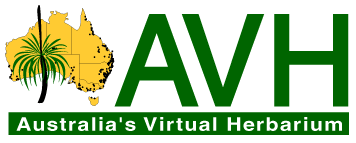 |
It is recognised by Australian herbaria as the prime reference for Australian
plants, not only for taxonomy, but also for fields such as ecology and horticulture;
it forms the basis for legislation relating to the natural environment. Maintenance
of APNI is strongly supported by the Council of Heads of Australian Herbaria
(CHAH), the peak body representing
Australian herbaria, and the botanical community as a whole. APNI is an integral
component of Australia's Virtual Herbarium
(AVH), a collaborative
project of all Australian herbaria to share botanical data from their collections
and provide access to comprehensive botanical information on-line. Commonwealth,
State and Territory governments and a consortium of private foundations which
agreed to a $10 million funding package in 2003 to complete the data capture of Australia's
six million botanical specimens held in the major herbaria. Further development
of APNI is an essential element linking all this information.
|
APNI is currently maintained as a modern relational database with links to the Australian National Herbarium specimen database, the living collections and photograph databases of the Australian National Botanic Gardens, the developing on-line Flora program of ABRS, and endangered species databases of the Department of the Environment and Water Resources, which underpin the Commonwealth EPBC legislation.
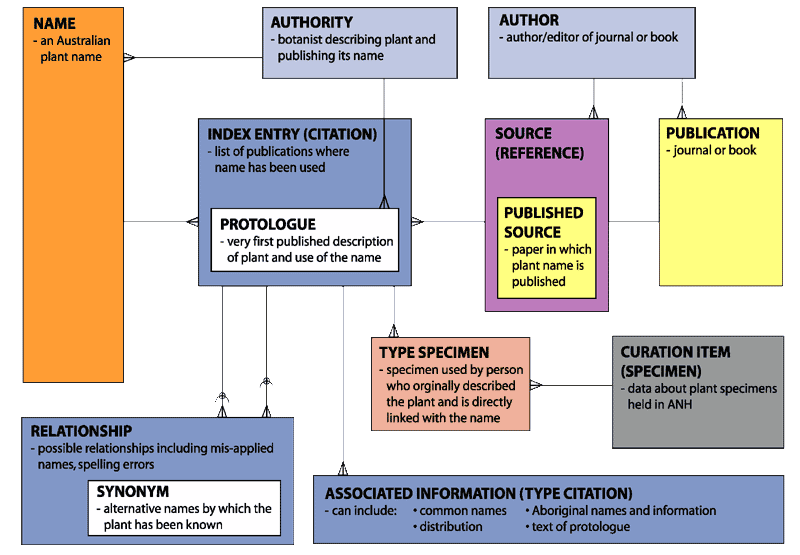
APNI has been available for query on the Internet since its publication in 1991. The active client base for APNI includes botanists, educators and students, ecologists, agriculturalists, foresters, environmental managers and decision-makers, horticulturalists, anthropologists and the general public. The APNI database pages are accessed via the Internet at the rate of 2900 queries per week.
APNI provides one of the main gateways to the Australia's Virtual Herbarium, and is the backbone for plant names and nomenclatural citations throughout this project. The Australian Plant Image Index (APII) provides information on 33,500 plant photographs at the ANBG. Digital images of these slides are progressively placed on the Internet, with APNI providing the underlying structure for the correct naming of images of Australian plants. These images, accessible through APNI, contribute to the long-term vision for Australia's Virtual Herbarium.
Recent developments in the international bioinformatics arena have identified the need to provide digital information on type specimens held in different herbaria around the world. It is recognised by our international colleagues that APNI has the database structure and all the components with which to manage electronic information about type specimens. Through its present involvement in the International Plant Names Index project (IPNI) APNI is well placed to make a significant contribution internationally.
|
APNI |
GCI |
IK |
|
| Total records |
|
|
|
| Geography |
|
|
|
| Names dating from |
|
|
|
 Source references for Swainsona formosa entry. |
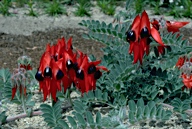 APNI
provides a census of names, accepted and previously used, for any plant, e.g.
Sturt's Desert Pea (Swainsona formosa)
APNI
provides a census of names, accepted and previously used, for any plant, e.g.
Sturt's Desert Pea (Swainsona formosa)
To compile such a list in the past involved an extensive literature search
compared with a click of the mouse from APNI.
While APNI offers a technical presentation of Australia's botanical nomenclature to the scientific community, What's Its Name (WIN) was developed as an alternative user-friendly entry point for the non-botanist. Focus group discussions with members of the horticulture trade, landcare and environmental groups, highlighted the need for succinct and comprehensive delivery of botanical nomenclature to inform clients of changes to plant names.
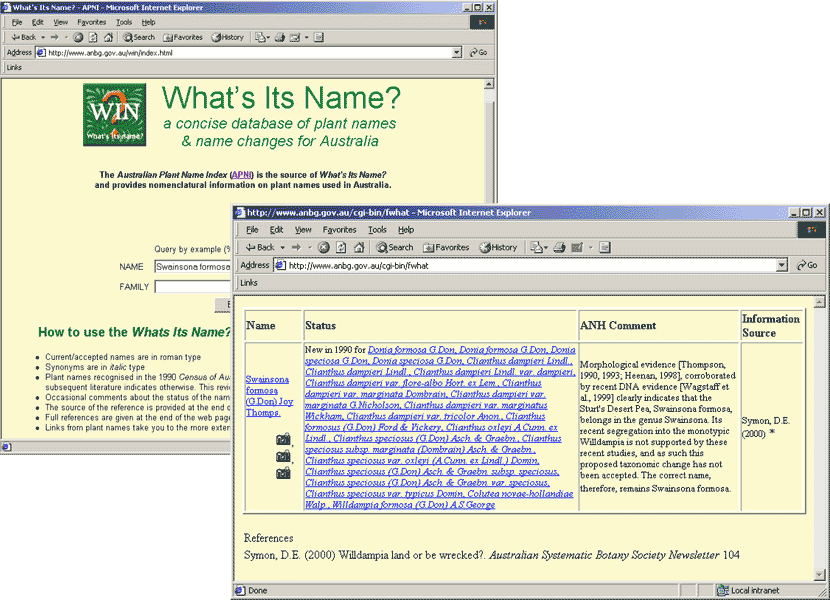
What's Its Name is derived from the APNI database and aims to deliver a concise overview of plant names and name changes via the Internet. It provides the current name in use for a plant and a cross-reference to any previously used names. In cases of discrepancy or ambiguity WIN provides a simple explanation of the scientific information suitable for the non-scientific user.
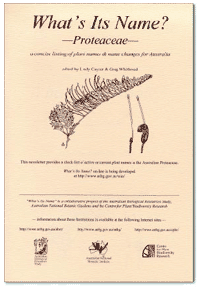 WIN
services a wide range of users, including those in the horticultural and agricultural
industries, botanists, conservation and landcare groups, gardeners, naturalists
and native plant enthusiasts. The web pages are accessed at a rate of about
900 queries per week.
WIN
services a wide range of users, including those in the horticultural and agricultural
industries, botanists, conservation and landcare groups, gardeners, naturalists
and native plant enthusiasts. The web pages are accessed at a rate of about
900 queries per week.
Because of its prominence in the horticulture industry the Proteaceae family was developed as a prototype for WIN. It was completed in 2001 and made available both on-line and published as a hard-copy checklist. Users are able to check which name is in use and which is no longer in use for species in this nationally significant plant group. Following favourable feedback from this initial project, data is now presented in WIN format for more than 30 plant families.
The Australian Plant Name Index is a database of national and international significance and partnerships have been established and are being sought for its continued maintenance and enhancement.
APNI is maintained at the Centre for Plant Biodiversity Research with staff resources and financial support from the Australian National Herbarium, Australian National Botanic Gardens and the Australian Biological Resources Study. The CPBR, ANBG and ABRS collaborate to further the updating and delivery of APNI and WIN.
The Centre for Plant Biodiversity Research is a jointly funded and managed facility between CSIRO Plant Industry and the Department of the Environment and Water Resources through the Australian National Botanic Gardens. Established under an agreement in 1993 the initial period of seven years has recently been formally extended for another ten years. The CPBR integrates the staff and resources of the two organizations focusing on scientific research in plant systematics, bioinformatics and conservation biology. The Council of Heads of Australian Herbaria is a strong supporter of APNI and provides guidance and support for its information content and the provision of information from each of the State and Territory herbaria.
The Herbarium Information Systems Committee (HISCOM), made up of IT staff from Australia's eight major herbaria, is working with staff of the Australian National Herbarium on database design and information management aspects of APNI, to enable sharing of plant name data between herbaria. APNI is a collaborative partner in the International Plant Name Index, and is working with the Royal Botanic Gardens, Kew and the Harvard University Herbaria to produce a single consistent list of plant names for the world. Partners are being sought to enhance the coverage of common names in APNI and to present this information as part of WIN. Client demand for information based on common and vernacular names is very high. It is highly desirable to extend the coverage of APNI to include Aboriginal plant names and their published source.